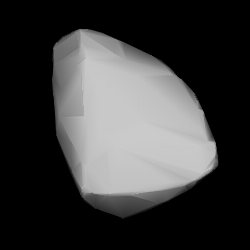 Shape model of TARDIS from its lightcurve | |
| Discovery [1] | |
|---|---|
| Discovered by | B. A. Skiff |
| Discovery site | Anderson Mesa Stn. |
| Discovery date | 3 May 1984 |
| Designations | |
| (3325) TARDIS | |
Named after | TARDIS (fictional time machine) [2] |
| 1984 JZ ·1958 VB1 1969 TP3 ·1975 VC8 1975 WF1 | |
| main-belt [1] ·(outer) Alauda [3] | |
| Orbital characteristics [1] | |
| Epoch 4 September 2017 (JD 2458000.5) | |
| Uncertainty parameter 0 | |
| Observation arc | 58.56 yr (21,390 days) |
| Aphelion | 3.2299 AU |
| Perihelion | 3.1397 AU |
| 3.1848 AU | |
| Eccentricity | 0.0142 |
| 5.68 yr (2,076 days) | |
| 45.895° | |
| 0° 10m 24.24s / day | |
| Inclination | 22.221° |
| 46.246° | |
| 86.099° | |
| Physical characteristics | |
| 28.238±0.469 km [4] 29.66±1.2 km(IRAS:9) [5] | |
| 0.0553±0.005(IRAS:9) [5] 0.067±0.010 [4] | |
| 11.5 [1] | |
3325 TARDIS (provisional designation: 1984 JZ) is a dark Alauda asteroid from the outer region of the asteroid belt, approximately 29 kilometers (18 miles) in diameter. It was discovered on 3 May 1984, by American astronomer Brian Skiff at Lowell's Anderson Mesa Station, Arizona, in the United States. [6] The asteroid was named TARDIS, after the fictional time machine and spacecraft from the science fiction television series Doctor Who . [2]